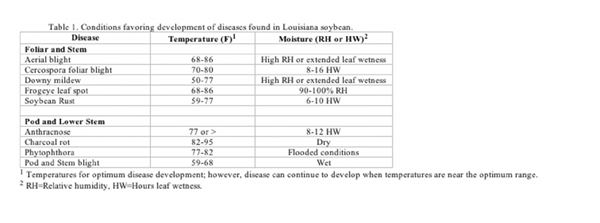|
Soybean Disease Identification And Management In Reduced-Tillage Production Systems: New Challenges
DR. BOYD PADGETT
ALEXANDRIA, LA.
Disease identification and development: specific environmental conditions for disease development are listed in table 1.
Aerial Blight (Rhizoctonia solani) (sheath blight in rice): Initial symptoms appear as water-soaked greasy blotches on the leaflets (usually in the lower to mid canopy). As the disease progresses, adjacent leaflets can be stuck together by fungal mycelium (white cottony in color). If favorable conditions persist, the foliage becomes brown and pods will have reddish-brown lesions and can abort from the plant. The disease is usually evident during and after the early reproductive stages of growth. The fungus survives in the soil and on plant debris.
Cercospora Blight/Purple Seed Stain (Cercospora kikuchii): The foliar symptoms are usually not evident until the mid to late reproductive stages of growth, but infection can occur early in the season. Initial symptoms are small chocolate brown lesions on the petioles near the leaflet. Foliar symptoms occur as a reddish brown to tan discoloration on the upper leaf surface in the upper canopy. Leaves have a leathery appearance. The fungus can sporulate in older lesions (resemble ashes). Advanced stages of this disease result in premature defoliation, discolored pods, and reduced seed quality. The seed phase is evidenced by purple-stained seed. The pathogen survives on seed, some weeds, and plant debris.
Downy mildew (Peronospora manshurica) is not a major threat to Louisiana soybean. Symptoms can be confused with soybean rust. Symptoms initiate as small pale green to yellow spots on the upper leaf surface. Older lesions may turn reddish to gray to dark brown. When the disease is active, grayish tufts of fungal mycelium (similar to dryer lint) can be found on the underside of the leaf opposite the yellow spot.
Frogeye leaf spot (Cercospora sojina): Symptoms are found predominately on the leaves, but can occur on the petioles, stems, and pods. Initially, small chocolate brown to purplish spots are present on the leaflets. Mature lesions have light brown to gray centers with a reddish brown to purplish margin. Stem lesions while rare are elliptical with red centers and dark brown to black margins. Pod lesions are circular to elliptical, sunken, and light gray to brown. Seeds infected with this pathogen exhibit grayish to light purple lesions. The pathogen survives on seed and infected plant debris.
Soybean Rust (Phakopsora pachyrhizi): Symptoms initiate in the lower canopy as small brown to tan raised pustules (volcano-like) on the lower leaf surface. Spores produced in the pustules resemble sand and are tan in color when young. Older spores are darker in color. As the disease progresses, the pustules can coalesce and cause the leaflets to defoliate. Symptoms are usually evident when soybean is in the mid to late reproductive growth stages. Pustules can also occur on petioles and pods when disease is severe. Kudzu is another host for this fungus.
Anthracnose (Colletotrichum truncatum): Early infections can result in pre- and postemergence damping-off. Foliar symptoms include petiole cankers, leaf rolling, necrosis of the laminar veins, and premature defoliation. The fungus can produce acervulli (fruiting bodies / black specks) on the stems and pods. If the disease continues to develop on the pods, seed quality will be compromised. The fungus overwinters in crop debris or infected seed.
Charcoal rot (Macrophomina phaseolina): Infected seed may not germinate or seedlings may die soon after emergence. Symptoms from plants with latent infections or mid to late season infections die prematurely during hot, dry weather. Symptoms can be associated with dry spots (sandy areas) in the field. The roots and lower stems are deteriorated, and the epidermal and sub-epidermal tissue will be silvery in color and dotted with black pepper-like sclerotia (survival structures). The fungus may survive in the seed coat, in host residue, or in the soil.
Phytophthora rot (Phytophthora spp.): Soybean may be affected during any growth stage. This disease is most common on heavy, tight soils prone to flooding. The fungus overwinters on crop residue in the soil. Symptoms include wilting and a chocolate brown lesion at the base of the stem. This lesion can extend several inches above the soil line.
Pod and Stem Blight (Diaporthe phaseolorum var. sojae) occurs frequently on the pods and stems. Infection can occur early in the season; however, signs of the disease are not evident until late season (R7). Pycnidia (fruiting bodies / black specks) occur in linear rows on the stems and pods. If favorable conditions persist, seed quality will be compromised. The fungus overwinters in crop residue or on seed.
CULTURAL PRACTICES, GENETIC RESISTANCE, AND FUNGICIDES
Tillage practices impact the initial inoculum present at planting and during the growing season. Reduced tillage practices result in more plant debris in the field. This plant debris can harbor plant pathogens and increase the risk to Cercospora foliar blight, pod diseases, and aerial blight. Rotate fields periodically to a non-host to reduce the initial inoculum. Plant when conditions favor rapid germination and seedling establishment. A healthy plant is the first step toward optimizing yields and preventing disease. Improve drainage within the field. This helps reduce the risk to some soilborne diseases such as Phytophthora rot. Practices that promote air movement within the canopy reduce the leaf wetness period and lessen the risk to some foliar diseases.
Disease resistant varieties should be the foundation of any disease management strategy. The LSU AgCenter conducts variety evaluations on research stations located throughout the state. When genetic resistance is not available, fungicides can be utilized for managing diseases. However, resistance has been documented in SOME, BUT NOT ALL, pathogen populations. Consult labels for proper rates and timings.∆
DR. BOYD PADGETT: Regional Director/Plant Pathologist, LSU AgCenter
|
|